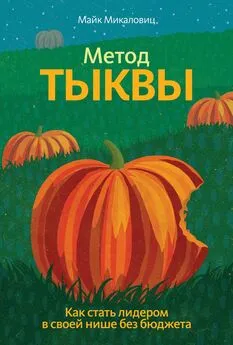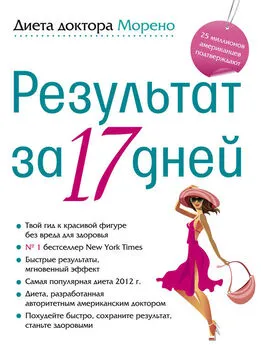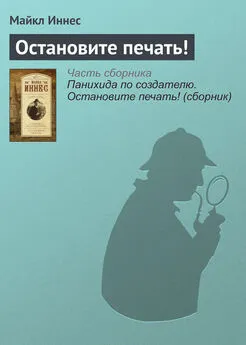Майк Морено - Как остановить старение и стать моложе. Результат за 17 дней
- Название:Как остановить старение и стать моложе. Результат за 17 дней
- Автор:
- Жанр:
- Издательство:Центрполиграф
- Год:2014
- Город:Москва
- ISBN:978-5-227-04968-1
- Рейтинг:
- Избранное:Добавить в избранное
-
Отзывы:
-
Ваша оценка:
Майк Морено - Как остановить старение и стать моложе. Результат за 17 дней краткое содержание
Доктор Майк Морено разработал четкую и простую в выполнении 17-дневную программу омоложения организма. Читателям предлагается сделать 4 простых шага, чтобы чувствовать себя моложе и здоровее. Каждый шаг программы сфокусирован на омоложении определенных частей вашего тела и организма: от сердца и легких до нервной системы и репродуктивных функций. Автор объясняет, как надо дышать, что нужно делать для укрепления иммунитета, каким образом сохранить гибкость и крепость суставов, остроту зрения и чувств и многое другое. Вы узнаете о своем организме так много интересного, что уже просто не сможете небрежно к нему относиться. Действуйте, у вас все получится!
Как остановить старение и стать моложе. Результат за 17 дней - читать онлайн бесплатно ознакомительный отрывок
Интервал:
Закладка:
Aoshiba, K., and A. Nagai. 2003. Oxidative stress, cell death, and other damage to alveolar epithelial cells induced by cigarette smoke. Tobacco
Induced Dis eases 1.3: 219-26. Accessed June 4, 2012. http://www.ncbi.nlm.nih.gov/ pubmed/19570263.
Asthma and Allergy Foundation of America. 2005. Asthma overview. http://www .aafa.org/display.cfm?id=8&cont=5.
Baik, H. W., and R. M. Russell. 1999. Vitamin B12 deficiency in the elderly. Annual Review of Nutrition 19: 357-77.
Centers for Disease Control and Prevention. 2011. Asthma in the US, Growing every year. CDC Vital Signs (May 2011).
Knekt, P., et al. 2002. Flavonoid intake and risk of chronic diseases. American Journal of Clinical Nutrition 76(3): 560-68.
Leboeuf-Yde, C., et al. 2005. Self-reported nonmusculoskeletal responses to chiropractic intervention: A multination survey. Journal of Manipulative and Physiological Therapeutics 28(5): 294-302; discussion 365-56.
Le Marchand, L., et al. 2000. Intake of flavonoids and lung cancer. Journal of the National Cancer Institute 92(2): 154-60.
Linseisen, J., et al. 2007. Fruit and vegetable consumption and lung cancer risk: Updated information from the European Prospective Investigation into Cancer and Nutrition (EPIC). International Journal of Cancer 121(5): 1103-14.
Noble, J. M., et al., 2009. Periodontitis is associated with cognitive impairment among older adults: analysis of NHANES-III. Journal of Neurology, Neurosurgery & Psychiatry 80(11): 1206-1211. http://www.ncbi.nlm.nih.gov/pmc/ articles/PMC3073380/.
Oh, R. C., and D. Brown. 2003. Vitamin B12 deficiency. American Family Physician 67(5): 979-86.
Pennypacker, L. C., et al. 1992. High prevalence of cobalamin deficiency in elderly outpatients. Journal of the American Geriatrics Society 40: 1197-204.
Rush University Medical Center. Breathe easier: tips for keeping your lungs healthy. http://www.rush.edu/rumc/page-1282236970456.html. May 21, 2012.
Schunemann, H.J., et al. 2001. The relation of serum levels of antioxidant vitamins C and E, retinol and carotenoids with pulmonary function in the general population. American Journal of Respiratory and Critical Care Medicine 163(5): 1246-55.
Schwartz, A. G., 2012. Genetic epidemiology of cigarette smoke-induced lung disease. Proceedings of the American Thoracic Society 9(2): 22-26.
Semba, R. D., et al., 2012. Serum carotenoids and pulmonary function in older community-dwelling women. Journal of Nutrition, Health, & Aging 16(4): 291-96.
Sepper, R., et al. 2012. Mucin5B expression by lung alveolar macrophages is increased in long-term smokers. Journal of Leukocyte Biology (May 16).
Studenski, S., et al. 2011. Gait speed and survival in older adults. Journal of the American Medical Association 305(1): 50-58.
U.S. Department of Agriculture. 2012. Agriculture Research Service, National Agri culture Library. National Nutrient Database for Standard Reference.
World Health Organization. 2011. Chronic obstructive pulmonary disease (COPD).
Fact Sheet N°315. http://www.who.int/mediacentre/factsheets/fs315/en/index.html.
Глава 5. Работоспособность мозга
Akbaraly, T. N., et al. 2007. Plasma selenium over time and cognitive decline in the elderly. Epidemiology 18(1): 52-58.
Ball, K., et al. 2002. Effects of cognitive training interventions with older adults.
A randomized controlled trial. Journal of the American Medical Association 288(18): 2271-81.
Caprio, T. V., and Williams, T. F. 2007. Comprehensive geriatric assessment. Practice of Geriatrics, 4th ed., chap 4.
Chung, C. S., and L. R. Caplan. 2007. Stroke and other neurovascular disorders. In: Goetz, C. G., ed. Textbook of Clinical Neurology, 3rd ed. Philadelphia: Saun ders Elsevier, chap. 45.
Durga, J., et al., 2005. Effect of lowering of homocysteine levels on inflammatory markers. A randomized controlled trial. Archives of Internal Medicine 165(12): 1388-94.
Ghosh, D., M. K. Mishra, S. Das, D. K. Kaushik, and A. Basu. 2009. Tobacco carcinogen induces microglial activation and subsequent neuronal damage. Journal of Neurochemistry 110: 1070-81.
Hile, E. S., and S. A. Studenski. 2007. Instability and falls. In: Duthie E. H., P. R. Katz, and M. L. Malone, eds., Practice of Geriatrics, 4th ed., chap. 17.
Ho, A. J., C. A. Raji, J. T. Becker, et al. 2010. Obesity is linked with lower brain volume in 700 AD and MCI patients. Neurobiology of Aging 31(8): 1326-39.
Kelkel, M., et al. 2010. Potential of the dietary antioxidants resveratrol and cur– cumin in prevention and treatment of hematologic malignancies. Molecules. 15(10): 7035-74.
Lambourne, K. 2006. The relationship between working memory capacity and physical activity rates in young adults. Journal of Sports Science and Medicine 5: 149-53.
Langon, A., et al. 2012. Control of microRNA expression as a new way for resveratrol to deliver its beneficial effects. Journal of Agriculture and Food Chemistry (May).
Luders, E., et al. 2011. Enhanced brain connectivity in long-term meditation practitioners. NeuroImage 57(4): 1308-16.
Masoumi, A., et al., 2009. 1alpha,25-dihydroxyvitamin D3 interacts with curcuminoids to stimulate amyloid-beta clearance by macrophages of Alzheimer’s disease patients. Journal of Alzheimer’s Disease 17(3): 703-17.
Milara, J., and J. Cortijo. 2012. Tobacco, inflammation, and respiratory tract cancer. Current Pharmaceutical Design. Accessed June 4, 2012. http://www.ncbi .nlm.nih.gov/pubmed/22632749.
Oude Griep, L. M., et al. 2011. Colors of fruit and vegetables and 10-year incidence of stroke. Stroke: A Journal of Cerebral Circulation. 42(11): 3190-95.
Pierluigi, Q., et al. 2004. Homocysteine, folate, and vitamin B-12 in mild cognitive impairment, Alzheimer disease, and vascular dementia. American Journal of Clinical Nutrition 80(1): 114-22.
Seeman, T. E., et al. 2011. Histories of social engagement and adult cognition: Midlife in the U.S. study. Journals of Gerontology, Series B, Psychological Sciences and Social Sciences 66(Suppl. 1): 141-52.
Small, G. W., et al. 2009. Your brain on Google: Patterns of cerebral activation during internet searching. American Journal of Geriatric Psychiatry 17(2): 116-26.
Stewart, R., et al. 2008. Oral health and cognitive function in the Third National Health and Nutrition Examination Survey (NHANES III) Psychosomatic Medicine. Journal of Biobehavioral Medicine 70(8): 936-41.
U.S. Department of Agriculture. 2012. Agriculture Research Service, National Agriculture Library. National Nutrient Database for Standard Reference. Maryland, Nutrient Data Laboratory.
U.S. National Library of Medicine and National Institutes of Health. 2010. Aging changes in the senses. http://www.nlm.nih.gov/medlineplus/ency/article/ 004013.htm.
Zandi, P. P., et al. 2004. Reduced risk of Alzheimer disease in users of antioxidant vitamin supplements: The Cache County Study. Archives of Neurology. 61(1): 82-88.
Глава 7. Ваш телохранитель
Algra, A., et al. 2012. Effects of regular aspirin on long-term cancer incidence and metastasis: A systematic comparison of evidence from observational studies versus randomised trials. Lancet Oncology 13(5): 518-27.
Arthur, J., et al. 2003. Selenium in the immune system. Journal of Nutrition 133(5): 14575-595.
Bennett, M. P., et al. 2003. The effect of mirthful laughter on stress and natural killer cell activity. Alternative Therapies in Health and Medicine 9(2): 38-45.
Choi, M. 2009. The not-so-sweet side of fructose. Journal of the American Society of Nephrology 20(3): 457-59.
Cole, S., et al. 2008. Sleep loss activates cellular inflammatory signaling. Biological Psychiatry 64(6): 538-40.
Edlund, M. 2012. Getting healthy now. Regenerating yourself – using the right information. Psychology Today (May 17). http://www.psychologytoday .com/blog/getting-healthy-now/201205/regenerating-yourself-using-the -right-information?page=2.
Geisler, C., et al. 2010. Vitamin D controls T cell antigen receptor signaling and activation of human T cells. Nature Immunology 11: 344-49.
Johnson, R., et al. 2010. The Effect of Fructose on Renal Biology and Disease. Journal of the American Society of Nephrology 21(12): 2036-39.
Miller, M., and W. Fry, 2009. The effect of mirthful laughter on the human cardiovascular system. Medical Hypotheses 73(5): 636.
Miller, M., et al. 2009. University of Maryland School of Medicine study shows laughter helps blood vessels function better.
Office of Dietary Supplements: National Institutes of Health. Dietary supplement fact sheet: Selenium. http://ods.od.nih.gov/factsheets/Selenium-Health Professional/.
Sugawara J., et al. 2010. Effect of mirthful laughter on vascular function. American Journal of Cardiology 106(6): 856-59.
Глава 8. Прислушайтесь к своим внутренним органам
American Cancer Society. 2011. Colorectal cancer. http://www.cancer.org/Cancer/ColonandRectumCancer/DetailedGuide/colorectl-cancer-key-statistics.
American Cancer Society. 2011. Stomach cancer. http://www.cancer.org/Cancer/ StomachCancer/DetailedGuide/stomach-cancerprevention.
American Cancer Society. 2011. What is small intestine cancer. http://www.cancer .org/Cancer/SmallIntestineCancer/DetailedGuide/smallintestine-cancer-what-is-small-intestine-cancer.
American Cancer Society. 2012. Stomach cancer overview. http://www.cancer.org/ Cancer/StomachCancer/OverviewGuide/stomach-canceroverview-what -causes.
American College of Gastroenterology. Acid reflux. http://patients.gi.org/topics/ acid-reflux/.
American College of Gastroenterology. 2010. Rectal problems. http://www.acg.gi.org/patients/women/rectal.asp.
Blot, W. J., et al. 1993. Nutrition intervention trials in Linxian, China: Supplementation with specific vitamin/mineral combinations, cancer incidence, and disease specific mortality in the general population. Journal of the National Cancer Institute 85(18): 1483-92.
Bogardus, S. T. 2006. What do we know about diverticular disease? A brief overview. Journal of Clinical Gastroenterology 40: S108-S11.
Centers for Disease Control and Prevention. 2006. Helicobacter pylori and peptic ulcer disease. The key to cure. http://www.cdc.gov/ulcer/keytocure.htm.
Chao, A., et al. 2002. Cigarette smoking, use of other tobacco products and stomach cancer mortality in US adults: The Cancer Prevention Study II. International Journal of Cancer 101(4): 380-89.
Hunt, R. H. 1996. Helicobacter pylori: From theory to practice. Proceedings of a symposium. American Journal of Medicine 100(5A): supplement.
Hunt, R. H., and A. B. R. Thompson. 1998. Canadian Helicobacter pylori Consensus Conference. Canadian Journal of Gastroenterology 12(1): 31-41.
Jacobs, E. J., et al. 2002. Vitamin C, vitamin E, and multivitamin supplement use and stomach cancer mortality in the Cancer Prevention Study II cohort. Cancer Epidemiology, Biomarkers, & Prevention 11(1): 35-41.
Jenab, M., et al. 2010. Association between pre-diagnostic circulation vitamin D concentration and risk of colorectal cancer in European populations: A nested case-control study. BMJ 340: b5500.
Johns Hopkins Health Alerts. October 2011. Diverticulosis and diverticulitis. http://www.johnshopkinshealthalerts.com/symptoms_remedies/diverticular_disorders/90-1 .html.
Johns Hopkins Medicine Health Alerts. October 2011. Digestive disorders. http://www.johnshopkinshealthalerts.com/alerts_index/digestive_health/19-1.html.
Читать дальшеИнтервал:
Закладка:







![Артем Сенаторов - Результат [Бизнес-роман о том, как стать предпринимателем, заработать денег и не сойти с ума] [litres]](/books/1063559/artem-senatorov-rezultat-biznes.webp)


